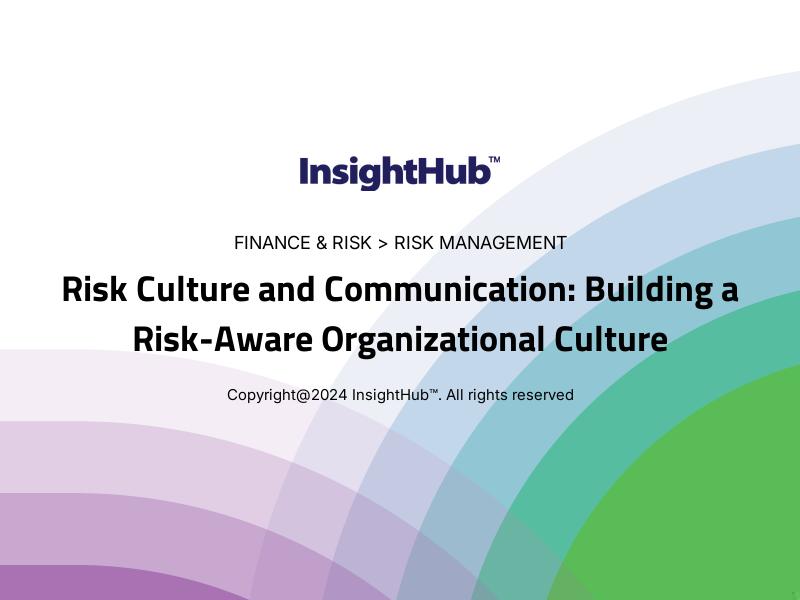
Risk Culture and Communication: Building a Risk-Aware Organizational Culture
This training is designed to help organizations develop a robust risk culture, ensuring that all employees understand the importance of risk management and are empowered to communicate risks effectively. The program emphasizes creating a risk-aware environment where proactive risk management is a part of everyday operations.
| Penanggung Jawab | Administrator |
|---|---|
| Terakhir diperbarui | 14/08/2024 |
| Waktu Penyelesaian | 6 jam 45 menit |
| Anggota | 1 |
Share Kursus Ini
Bagikan Link
Share di Social Media
Share melalui Email
Silakan login untuk membagikan ini Risk Culture and Communication: Building a Risk-Aware Organizational Culture dengan email.
What you will learn
- Definition of Risk Culture
- Components of Risk Culture
- Benefits of a Strong Risk Culture
- Case Studies of Effective Risk Cultures
- Leadership and Governance
- Risk Policies and Procedures
- Training and Awareness Programs
- Incentives and Accountability
- Risk Communication Channels
- Creating Risk Awareness Campaigns
- Integrating Risk Management into Daily Activities
- Engaging Employees in Risk Discussions
- Tools and Technologies for Risk Awareness
- Principles of Risk Communication
- Identifying Key Stakeholders
- Developing Clear Communication Channels
- Using Data and Analytics to Inform Communication
- Feedback Mechanisms and Continuous Improvement
- Setting the Tone from the Top
- Leadership Engagement and Risk Oversight
- Modeling Risk-Awareness Behavior
- Encouraging Open Communication
- Assessing Current Risk Culture
- Identifying Gaps and Improvement Areas
- Setting Measurable Objectives
- Implementing and Monitoring Progress
- Review and Adaptation Strategies
Program Structure
-
Introduction to Risk Culture4 Lessons · 1 j
-
Definition of Risk Culture
-
Components of Risk Culture
-
Benefits of a Strong Risk Culture
-
Case Studies of Effective Risk Cultures
-
-
Building Blocks of Risk Culture5 Lessons · 1 j 15 mnt
-
Leadership and Governance
-
Risk Policies and Procedures
-
Training and Awareness Programs
-
Incentives and Accountability
-
Risk Communication Channels
-
-
Strategies for Promoting Risk Awareness4 Lessons · 1 j
-
Creating Risk Awareness Campaigns
-
Integrating Risk Management into Daily Activities
-
Engaging Employees in Risk Discussions
-
Tools and Technologies for Risk Awareness
-
-
Effective Risk Communication5 Lessons · 1 j 15 mnt
-
Principles of Risk Communication
-
Identifying Key Stakeholders
-
Developing Clear Communication Channels
-
Using Data and Analytics to Inform Communication
-
Feedback Mechanisms and Continuous Improvement
-
-
Role of Leadership in Risk Culture4 Lessons · 1 j
-
Setting the Tone from the Top
-
Leadership Engagement and Risk Oversight
-
Modeling Risk-Awareness Behavior
-
Encouraging Open Communication
-
-
Action Plan Development5 Lessons · 1 j 15 mnt
-
Assessing Current Risk Culture
-
Identifying Gaps and Improvement Areas
-
Setting Measurable Objectives
-
Implementing and Monitoring Progress
-
Review and Adaptation Strategies
-
About the course
This training is designed to help organizations develop a robust risk culture, ensuring that all employees understand the importance of risk management and are empowered to communicate risks effectively. The program emphasizes creating a risk-aware environment where proactive risk management is a part of everyday operations.
Pada pelatihan ini Anda akan mempelajari:
- Understand the concept and importance of a strong risk culture.
- Identify key elements that contribute to an effective risk culture.
- Learn strategies for fostering risk awareness and communication in the organization.
- Understand the role of leadership in shaping risk culture.
- Develop actionable plans to enhance risk culture within the organization.
Metode pembelajaran dilaksanakan melalui:
- Interactive Lectures
- Group Discussions
- Case Studies
- Workshops and Practical Exercises
- Role-Playing Scenarios
- Feedback and Reflection Sessions
Requirements
Tidak ada persyaratan khusus untuk mengikuti pelatihan ini.
Who should take this course
Risk managers, compliance officers, department heads, senior management, and other professionals involved in risk management within the organization.